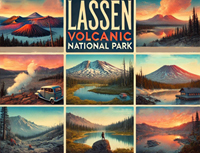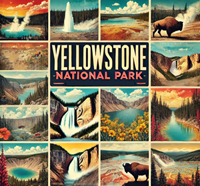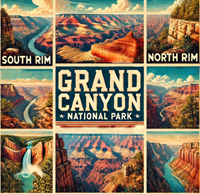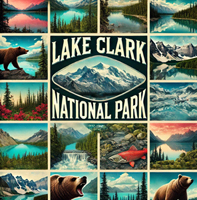

Embark on a journey curated by seasoned explorers William and Hui Cha Stanek, who have spent decades immersing themselves in the diverse landscapes of North America. These itineraries are more than just travel plans - they are thoughtfully crafted adventures designed to help you connect with the natural world, discover hidden gems, and create lasting memories.
National Parks Index | US Itineraries Index | American Roadtrips Index

Bring home a Bugville Critters book and watch as your child's love for reading and learning grows with every page. Hand-painted illustrations bring the heartwarming stories to life. Ask your librarian to add Bugville Critters to the library's digital collection today!
Discover William Stanek's Exclusive Art Collection
Explore and purchase the stunning art featured on this site. Own a piece of William Stanek's unique and captivating artwork today!
(May 9, 2025) Exploring Rocky Mountain and Great Sand Dunes: A 3-day Dual Adventure
Introduction: A Journey to Colorado's Majestic Landscapes
It was late September, the kind of crisp, cool morning that hinted at the onset of autumn, when Hui Cha and I first set out on our journey through two of Colorado's most breathtaking national parks – Rocky Mountain National Park and Great Sand Dunes National Park and Preserve. The mountains were already dusted with early snow, and the air was filled with the scent of pine and the promise of adventure.
For Hui Cha, this trip was a reunion with nature. Growing up in bustling Seoul, her connection to the natural world was limited to the city's parks and the occasional family trip to the countryside. Colorado's vast, untamed wilderness was something new for her, something that spoke to a deep, unspoken part of her soul. For me, William, it was an opportunity to immerse myself in landscapes that had long captivated my imagination. As a photographer, the contrast between the towering peaks of the Rockies and the surreal, shifting sands of the dunes was a dream come true.
Our journey began in Estes Park, the gateway to Rocky Mountain National Park. The town was buzzing with the excitement of the annual elk rut, and as we made our way into the park, we were greeted by the sight of bull elk bugling in the early morning mist. The sight was otherworldly, like stepping into a scene from a bygone era when the land was wild and untouched.
From the rugged, snow-capped peaks of Rocky Mountain National Park to the otherworldly landscape of Great Sand Dunes, this trip was about more than just capturing stunning images. It was about experiencing the deep sense of peace and connection that comes from being in such awe-inspiring places, where the natural world still reigns supreme.
In this guide, we'll take you through our detailed itineraries, share our best tips for capturing the unique beauty of these parks, and offer alternative activities for those seeking a less strenuous adventure. Whether you have just one day or a full three days to explore, this guide will help you make the most of your journey through these incredible Colorado landscapes.
Day 1: Discovering the Majesty of Rocky Mountain National Park
Morning: Sunrise at Bear Lake
6:00 AM - Sunrise at Bear Lake
Overview: Start your day in Rocky Mountain National Park with a sunrise at Bear Lake, one of the park's most iconic locations. The lake is surrounded by towering peaks, and in the early morning light, the reflection of the mountains on the still water creates a scene of almost magical beauty.
Tips from William: "Arrive at least 45 minutes before sunrise to secure your spot and set up your gear. Use a wide-angle lens to capture the full scene, and a polarizing filter to reduce glare on the water. The best shots often come just before sunrise when the sky is filled with soft, pastel colors. Try to include some foreground elements, like the rocks or trees along the shore, to add depth to your composition."
Insights from Hui Cha: "The mornings can be cold, especially as autumn approaches, so dress in layers and bring a thermos of hot coffee or tea. The quiet stillness of the morning at Bear Lake is something truly special – take a moment to just breathe it in and appreciate the beauty of the moment."
How to Access Bear Lake:
- Location: Bear Lake is located in the southeastern part of Rocky Mountain National Park.
- Travel Directions: From Estes Park, take US Highway 36 into Rocky Mountain National Park and follow signs to the Bear Lake Trailhead. The drive takes about 30 minutes.
- Trail Details: The Bear Lake Loop is a short, easy 0.6-mile trail that circles the lake. The trail is well-maintained and accessible, making it suitable for all visitors.
Alternative Activity: Sprague Lake
- For a less crowded but equally beautiful sunrise experience, consider visiting Sprague Lake. This spot offers similar reflections and is just a short drive from Bear Lake.
Photographic Techniques:
- Reflections: To capture the reflection of the mountains in the lake, make sure the water is calm. Use a tripod and set your camera to a small aperture (f/11 or f/16) to ensure both the foreground and background are in sharp focus.
- Golden Hour Lighting: The soft light just after sunrise will add a warm glow to your images. Adjust your white balance to enhance the golden tones.
- HDR Photography: Consider bracketing your shots to capture the full dynamic range of light, especially if there's a significant difference between the bright sky and the darker foreground.
Exploring the Area:
- After photographing Bear Lake, take a leisurely walk around the loop trail. The early morning light filtering through the trees creates beautiful opportunities for close-up shots of the foliage and any lingering morning mist.
Midday: Hiking the Emerald Lake Trail
10:00 AM - Emerald Lake Hike
Overview: The hike to Emerald Lake is one of the most popular in Rocky Mountain National Park, offering stunning views of three alpine lakes – Nymph Lake, Dream Lake, and finally, Emerald Lake. The trail is relatively short but offers a lot of photographic opportunities along the way.
Tips from William: "The midday light can be harsh, so focus on capturing the textures and details of the landscape. Use a polarizing filter to enhance the colors of the water and the sky, and consider shooting in black-and-white to emphasize the contrast between the snow-capped peaks and the dark, reflective surfaces of the lakes."
Insights from Hui Cha: "This hike is moderate, with some steep sections, so be prepared with sturdy shoes and plenty of water. The trail can get crowded, especially on weekends, so start early if possible. Take your time at each lake – each one has its own unique beauty, and it's worth stopping to enjoy the view."
How to Access the Emerald Lake Trail:
- Location: The trailhead for Emerald Lake is located at Bear Lake, making it an easy continuation from your sunrise shoot.
- Travel Directions: From the Bear Lake parking area, follow the signs for the Emerald Lake Trail. The hike is 3.5 miles round-trip with an elevation gain of about 700 feet.
- Trail Details: The trail is well-marked and maintained, but the higher elevation can make it feel more strenuous. The first part of the trail leads to Nymph Lake, then continues on to Dream Lake and finally to Emerald Lake.
Alternative Activity: Alberta Falls
- If the Emerald Lake hike feels too challenging, consider the shorter hike to Alberta Falls. This 1.7-mile round-trip hike leads to a beautiful waterfall and is less strenuous, with plenty of scenic views along the way.
Photographic Techniques:
- Water Reflections: The clear waters of the lakes offer great opportunities for reflection photography. Look for spots where the trees and mountains are mirrored in the water, and use a polarizing filter to reduce glare and enhance the colors.
- Long Exposure: At Alberta Falls or any of the other smaller cascades along the trail, try using a slow shutter speed (1/4 to 1 second) to create a smooth, silky effect on the water.
- Wide-Angle Shots: Use a wide-angle lens to capture the full scope of the landscape, including the surrounding peaks and the lake in the foreground.
Exploring the Area:
- After reaching Emerald Lake, take some time to relax and enjoy the view. The alpine scenery here is breathtaking, and it's a great place to sit quietly and take in the beauty of the mountains.
Afternoon: Driving Trail Ridge Road
1:30 PM - Trail Ridge Road
Overview: Trail Ridge Road is the highest continuous paved road in North America, offering stunning views of the Rocky Mountains as it winds its way through the park. The road takes you above the tree line, where you can experience the unique tundra ecosystem and panoramic vistas of the surrounding peaks.
Tips from William: "Trail Ridge Road offers some of the best landscape photography opportunities in the park. Use a wide-angle lens to capture the expansive views, and a telephoto lens to zoom in on the distant peaks. The light can be harsh in the afternoon, so consider using a polarizing filter to deepen the blue of the sky and reduce glare on the rocks."
Insights from Hui Cha: "The drive can be long and winding, so take your time and stop at the various pullouts to stretch your legs and enjoy the views. Be prepared for cooler temperatures as you climb in elevation, and keep an eye out for wildlife – bighorn sheep and elk are often seen along this road."
How to Access Trail Ridge Road:
- Location: Trail Ridge Road stretches from Estes Park on the east side of the park to Grand Lake on the west.
- Travel Directions: From the Bear Lake area, return to the main road and follow signs for Trail Ridge Road. The drive from Estes Park to the Alpine Visitor Center takes about 45 minutes, with plenty of scenic stops along the way.
- Points of Interest: Key stops along Trail Ridge Road include Many Parks Curve, Rainbow Curve, Forest Canyon Overlook, and the Alpine Visitor Center.
Alternative Activity: Old Fall River Road
- For a more rugged experience, consider driving Old Fall River Road. This one-way, unpaved road offers a slower, more intimate journey through the park and leads to the Alpine Visitor Center.
Photographic Techniques:
- Panoramic Shots: The sweeping vistas along Trail Ridge Road are perfect for panoramic photography. Take multiple shots from left to right and stitch them together in post-processing to create a wide, sweeping view of the mountains.
- Telephoto Details: Use a telephoto lens to zoom in on the details of the distant peaks, such as snow patches, rock formations, or small lakes nestled in the valleys.
- Foreground Interest: Include some of the tundra plants or rocks in the foreground to add depth and context to your landscape shots.
Exploring the Area:
- After driving Trail Ridge Road, stop at the Alpine Visitor Center to learn more about the park's unique alpine tundra ecosystem. The center offers exhibits, a gift shop, and a caf�, making it a great place to take a break before continuing your journey.
Evening: Sunset at Moraine Park
6:30 PM - Moraine Park
Overview: End your day in Rocky Mountain National Park with a sunset at Moraine Park, a large, open valley known for its stunning views of the surrounding mountains and abundant wildlife. The soft evening light creates a beautiful, golden glow over the meadows, making it a perfect spot for photography.
Tips from William: "Arrive about an hour before sunset to set up your shot. Use a wide-angle lens to capture the entire scene, and a telephoto lens to zoom in on any wildlife that might be grazing in the meadows. The golden hour light will add a warm, soft glow to your images, so be ready to shoot quickly as the light changes."
Insights from Hui Cha: "This is a peaceful spot to reflect on your day and take in the beauty of the park. Bring a blanket or chair to sit on, and enjoy the quiet as the sun dips below the mountains. The sound of the wind rustling through the grass and the distant bugling of elk is a perfect way to end the day."
How to Access Moraine Park:
- Location: Moraine Park is located in the eastern part of Rocky Mountain National Park, near the Beaver Meadows Entrance.
- Travel Directions: From Trail Ridge Road, head east towards Estes Park and turn off at the Moraine Park Campground Road. Follow the road to the parking area, where you'll find several trails leading into the valley.
- Trail Details: There's no formal trail at Moraine Park, but the area is open for exploration. The meadows are flat and easy to navigate, making it suitable for all visitors.
Alternative Activity: Bear Lake
- For a more structured sunset location, consider returning to Bear Lake for sunset. The changing light creates a completely different atmosphere compared to sunrise, offering new photographic opportunities.
Photographic Techniques:
- Golden Hour Lighting: The warm, golden light just before sunset is ideal for landscape photography. Use this light to highlight the grasses, trees, and mountains in your composition.
- Wildlife Photography: Moraine Park is a great place to spot elk, especially during the fall rut. Use a telephoto lens to capture the details of the animals, but remember to keep a safe distance.
- Silhouettes: As the sun sets behind the mountains, the trees and animals in the foreground can create dramatic silhouettes against the colorful sky. Use a small aperture (f/16 or f/22) to create a starburst effect as the sun dips below the horizon.
Exploring the Area:
- After sunset, take a leisurely drive back to Estes Park. The town offers plenty of dining options and local shops where you can unwind and reflect on your day in the park.
Day 2: Exploring the Mystical Landscapes of Great Sand Dunes National Park and Preserve
Morning: Sunrise at the Dunes
6:00 AM - Sunrise at Great Sand Dunes
Overview: Begin your exploration of Great Sand Dunes National Park with a sunrise over the dunes, the tallest in North America. The first light of day transforms the sand into a palette of golden hues, with the distant Sangre de Cristo Mountains providing a dramatic backdrop.
Tips from William: "The early morning light is soft and warm, perfect for capturing the intricate patterns and textures of the sand. Use a wide-angle lens to capture the vastness of the dunes, and a telephoto lens to zoom in on the ridges and shadows. A tripod is essential for stability, especially if you're shooting in low light."
Insights from Hui Cha: "The mornings can be cold, especially at higher elevations, so dress warmly and bring a thermos of hot tea or coffee. Walking on the dunes can be challenging, so take your time and enjoy the unique experience of being surrounded by miles of sand."
How to Access the Dunes:
- Location: The main dune field is located near the visitor center in Great Sand Dunes National Park.
- Travel Directions: From the park entrance, follow the main road to the Dunes Parking Area, located near the Great Sand Dunes Visitor Center. The drive takes about 20 minutes from the entrance.
- Trail Details: There are no formal trails in the dunes, but you can explore freely. The sand can be challenging to walk on, so be prepared for a workout as you climb the dunes.
Alternative Activity: Mosca Pass Trail
- For a less strenuous but still scenic morning hike, consider the Mosca Pass Trail. This 7-mile round-trip hike offers beautiful views of the surrounding mountains and is especially lovely in the early morning light.
Photographic Techniques:
- Golden Hour Lighting: The soft, golden light just after sunrise will highlight the ripples and ridges in the sand. Adjust your white balance to enhance the warm tones of the scene.
- Patterns and Textures: Focus on the patterns created by the wind in the sand, such as ripples and dunes. A telephoto lens can help you isolate these details and create abstract compositions.
- Silhouettes: Use the low angle of the sun to create dramatic silhouettes of the dunes and any hikers or wildlife you encounter. Position yourself so that the sun is just behind a dune to create a striking image.
Exploring the Area:
- After photographing the dunes, take some time to explore the surrounding area. The Medano Creek, located near the base of the dunes, offers a unique opportunity to capture reflections and the interaction between water and sand.
Midday: Exploring Medano Pass
10:00 AM - Medano Pass Primitive Road
Overview: Medano Pass Primitive Road offers a rugged, off-the-beaten-path experience for those with a high-clearance 4WD vehicle. The road takes you deep into the park, following Medano Creek and providing access to remote campsites, hiking trails, and stunning views of the Sangre de Cristo Mountains.
Tips from William: "The drive itself offers plenty of photographic opportunities, from the winding creek to the towering sand dunes in the distance. Use a wide-angle lens to capture the expansive landscape, and a telephoto lens to zoom in on the details of the creek and the surrounding vegetation. The light can be harsh in the midday sun, so consider using a polarizing filter to reduce glare and enhance the colors."
Insights from Hui Cha: "This road can be challenging, especially after a rainstorm, so be sure to check the conditions before you go. Pack a picnic lunch and enjoy a quiet meal at one of the remote campsites along the road – it's a peaceful way to experience the solitude of the park."
How to Access Medano Pass:
- Location: Medano Pass Primitive Road begins near the main dune field and continues for about 22 miles into the Sangre de Cristo Mountains.
- Travel Directions: From the Dunes Parking Area, head east towards the Medano Pass Road entrance. The road is unpaved and can be rough, so a high-clearance 4WD vehicle is required.
- Points of Interest: Key stops along Medano Pass include Medano Creek, Sand Pit, Castle Creek, and the Medano Pass Summit. Each offers unique landscapes and opportunities for photography.
Alternative Activity: Zapata Falls
- For a shorter, more accessible adventure, consider visiting Zapata Falls. Located just outside the park, this 0.9-mile hike leads to a stunning waterfall hidden in a narrow gorge.
Photographic Techniques:
- Water and Sand: Look for spots where Medano Creek flows over the sand, creating interesting patterns and reflections. Use a slow shutter speed to capture the movement of the water, and a polarizing filter to reduce glare.
- Landscape Photography: The towering dunes and distant mountains create a dramatic landscape that's perfect for wide-angle photography. Use the road itself as a leading line to draw the viewer's eye into the scene.
- Detail Shots: Focus on the smaller details along the road, such as wildflowers, rocks, or animal tracks. These close-ups can add variety to your landscape portfolio.
Exploring the Area:
- After exploring Medano Pass, consider hiking one of the trails that branch off from the road, such as the Mosca Pass Trail or the Dunes Overlook Trail. Each offers unique perspectives of the park and opportunities for quiet reflection.
Afternoon: Hiking the Dunes Overlook Trail
1:30 PM - Dunes Overlook Trail
Overview: The Dunes Overlook Trail offers a moderate hike with stunning views of the dune field and the surrounding mountains. This trail is perfect for an afternoon adventure, providing a different perspective on the park's unique landscape.
Tips from William: "The afternoon light can be harsh, but it's perfect for capturing the contrast between the bright sand and the dark mountains. Use a polarizing filter to deepen the blue of the sky and reduce glare on the sand. The overlook itself offers a panoramic view of the dunes, so bring a wide-angle lens to capture the full scope of the landscape."
Insights from Hui Cha: "This hike is about 2.5 miles round-trip and involves some elevation gain, so be prepared with plenty of water and sun protection. The view from the top is worth the effort, offering a sweeping panorama of the entire dune field and the Sangre de Cristo Mountains beyond."
How to Access the Dunes Overlook Trail:
- Location: The trailhead for the Dunes Overlook is located near the visitor center in Great Sand Dunes National Park.
- Travel Directions: From the visitor center, follow the main road towards the Dunes Parking Area. The trailhead is well-marked and located just off the main road.
- Trail Details: The trail is 2.5 miles round-trip with moderate elevation gain. The path is well-maintained and offers several viewpoints along the way.
Alternative Activity: Montville Nature Trail
- For a shorter, easier hike, consider the Montville Nature Trail. This 0.5-mile loop offers beautiful views of the surrounding mountains and is a great option for families or those looking for a less strenuous activity.
Photographic Techniques:
- Wide-Angle Landscapes: The view from the overlook is perfect for wide-angle landscape photography. Include some foreground elements, such as the vegetation or rocks, to add depth to your composition.
- Telephoto Details: Use a telephoto lens to zoom in on the details of the dune field, such as the ridges and shadows. These close-ups can create abstract, almost otherworldly images.
- Golden Hour: If you time your hike to arrive at the overlook just before sunset, you'll be rewarded with the soft, golden light of the late afternoon. This light is ideal for capturing the warm tones of the sand and the cool blues of the mountains.
Exploring the Area:
- After your hike, consider stopping by the visitor center to learn more about the park's unique geology and history. The center offers exhibits, a gift shop, and information about the park's many attractions.
Evening: Sunset at the Dunes
6:00 PM - Sunset at Great Sand Dunes
Overview: End your day with a sunset at the dunes, one of the most magical experiences in Great Sand Dunes National Park. The soft evening light creates a palette of pinks, purples, and golds, transforming the landscape into a surreal, dreamlike scene.
Tips from William: "Arrive about an hour before sunset to set up your shot. Use a wide-angle lens to capture the entire scene, and a graduated neutral density filter to balance the exposure between the bright sky and the darker sand. The best shots often come just after the sun has dipped below the horizon when the sky is filled with soft, pastel colors."
Insights from Hui Cha: "This is a peaceful way to end your day in the park. Bring a blanket or chair to sit on, and enjoy the quiet as the sun sets behind the mountains. The changing light creates a constantly shifting landscape, so keep shooting to capture the full range of colors."
How to Access the Dunes for Sunset:
- Location: The main dune field is located near the visitor center in Great Sand Dunes National Park.
- Travel Directions: From the Dunes Overlook Trail, return to the main road and head towards the Dunes Parking Area. The dunes are just a short walk from the parking lot.
- Trail Details: There are no formal trails in the dunes, but you can explore freely. The sand can be challenging to walk on, so take your time and enjoy the experience.
Alternative Activity: Medano Creek
- For a different perspective, consider watching the sunset from Medano Creek. The reflections in the water add a unique element to your sunset photography, and the creek is easily accessible from the Dunes Parking Area.
Photographic Techniques:
- Golden Hour Lighting: The warm, golden light just before sunset is ideal for landscape photography. Use this light to highlight the textures and patterns in the sand.
- Silhouettes: As the sun sets behind the dunes, the ridges and peaks create dramatic silhouettes against the colorful sky. Position yourself so that the sun is just behind a dune to create a striking image.
- Long Exposures: After the sun has set, experiment with longer exposures to capture the soft, fading light and the subtle colors in the sky.
Exploring the Area:
- After sunset, consider staying a bit longer for some stargazing. The clear, dark skies of Great Sand Dunes National Park offer excellent conditions for night photography, and the view of the Milky Way rising above the dunes is truly spectacular.
Day 3: Connecting the Parks and Capturing the Final Moments
Morning: Sunrise at Moraine Park (Again)
6:00 AM - Sunrise at Moraine Park
Overview: Return to Rocky Mountain National Park for a second sunrise at Moraine Park, this time with the benefit of familiarity. With your previous experience, you can experiment with different compositions and techniques that you may have missed on your first visit.
Tips from William: "This time, focus on capturing the subtle changes in the light as the sun rises. Use a wide-angle lens to capture the entire scene, and a telephoto lens to zoom in on any wildlife you encounter. The morning mist over the meadows can create a magical atmosphere, so be sure to capture that as well."
Insights from Hui Cha: "Returning to a location can offer a deeper connection to it. Take this opportunity to explore different angles and perspectives, and to notice the subtle changes in the light and atmosphere that make each visit unique."
How to Access Moraine Park:
- Location: Same as Day 1 – Moraine Park is located in the eastern part of Rocky Mountain National Park, near the Beaver Meadows Entrance.
- Travel Directions: Follow the same route as before to reach the Moraine Park parking area.
- Trail Details: There are no formal trails, but the area is open for exploration. The meadows are flat and easy to navigate.
Photographic Techniques:
- Morning Mist: Look for areas where the morning mist lingers over the meadows. Use a telephoto lens to capture the misty layers, or a wide-angle lens to include the surrounding mountains.
- Golden Hour Lighting: The soft, golden light just after sunrise is ideal for capturing the warm tones of the grass and the cool blues of the mountains. Adjust your white balance to enhance these colors.
- Wildlife Photography: Moraine Park is a great place to spot elk and other wildlife in the early morning. Use a telephoto lens to capture the details of the animals, but remember to keep a safe distance.
Exploring the Area:
- After photographing Moraine Park, consider exploring the nearby Cub Lake Trail. This moderate hike offers beautiful views of the surrounding mountains and is especially lovely in the early morning light.
Midday: Driving the Scenic Peak to Peak Highway
11:00 AM - Peak to Peak Scenic Byway
Overview: Spend your late morning driving along the Peak to Peak Scenic Byway, a stunning drive that offers breathtaking views of the Rocky Mountains as it winds through the forests and valleys of Colorado. This drive provides a relaxing way to explore the area and offers plenty of opportunities to stop and take photographs.
Tips from William: "The Peak to Peak Scenic Byway is a great place to practice landscape photography from the comfort of your car. Use a polarizing filter to enhance the colors of the sky and the mountains, and a telephoto lens to zoom in on the details of the peaks and forests. Keep an eye out for wildlife, especially deer and elk, which are often spotted along the road."
Insights from Hui Cha: "This drive is a peaceful way to explore the area without the need for strenuous hiking. Pack a picnic and stop at one of the many pullouts to enjoy the views and take a break. It's also a great way to see some of the area's hidden gems that aren't as well-known as the main attractions."
How to Access the Peak to Peak Scenic Byway:
- Location: The Peak to Peak Scenic Byway stretches from Estes Park to Central City, Colorado.
- Travel Directions: From Moraine Park, head east towards Estes Park and follow signs for the Peak to Peak Scenic Byway. The road offers numerous pullouts and scenic overlooks along the way.
- Points of Interest: Along the way, stop at sites such as Lily Mountain, Allenspark, and the historic town of Nederland.
Alternative Activity: Wild Basin Area
- For a more active midday experience, consider exploring the Wild Basin area of Rocky Mountain National Park. This area offers several hiking trails, including the popular Copeland Falls Trail, which leads to a series of beautiful waterfalls.
Photographic Techniques:
- Wide-Angle Landscapes: The sweeping vistas along the Peak to Peak Scenic Byway are perfect for wide-angle landscape photography. Include the road itself as a leading line to draw the viewer's eye into the scene.
- Telephoto Details: Use a telephoto lens to zoom in on distant details, such as the rocky outcrops or the patchwork of forest and meadows. These close-ups can add variety to your landscape portfolio.
- Color and Contrast: The deep greens of the forests contrast beautifully with the blue of the sky and the white of the snow-capped peaks. Use this color contrast to create striking images that showcase the unique beauty of the mountains.
Exploring the Area:
- After driving the Peak to Peak Scenic Byway, consider stopping for lunch in the mountain town of Nederland, known for its quirky charm and beautiful surroundings. The town offers several dining options and local shops, making it a great place to relax and unwind.
Afternoon: Exploring the Tundra on Trail Ridge Road
2:00 PM - Tundra Communities Trail
Overview: The Tundra Communities Trail offers a short, accessible hike that takes you into the heart of the alpine tundra, one of the most unique ecosystems in Rocky Mountain National Park. This trail is perfect for an afternoon adventure, providing stunning views of the surrounding peaks and a close-up look at the hardy plants and animals that call this harsh environment home.
Tips from William: "The tundra offers a different kind of beauty, with its low-growing plants and expansive views. Use a wide-angle lens to capture the full scope of the landscape, and a macro lens to focus on the details of the tiny flowers and lichens that thrive in this environment. The light in the afternoon can be harsh, so consider using a polarizing filter to reduce glare and enhance the colors."
Insights from Hui Cha: "This is a short, easy hike, but the high elevation can make it feel more challenging. Take your time and enjoy the unique beauty of the tundra. The trail is well-marked, but be sure to stay on the path to protect the fragile plants that grow here."
How to Access the Tundra Communities Trail:
- Location: The trailhead for the Tundra Communities Trail is located along Trail Ridge Road, near the Rock Cut parking area.
- Travel Directions: From Estes Park, take Trail Ridge Road west for about 15 miles. The trailhead is well-marked and located just off the main road.
- Trail Details: The trail is a 0.5-mile loop with minimal elevation gain. The path is well-maintained and offers several interpretive signs along the way.
Alternative Activity: Forest Canyon Overlook
- For a shorter, easier walk, consider visiting the Forest Canyon Overlook. This viewpoint offers impressive views of the canyon and surrounding peaks, with minimal walking required.
Photographic Techniques:
- Wide-Angle Landscapes: The vastness of the tundra is best captured with a wide-angle lens. Include some foreground elements, such as the tundra plants or rocks, to add depth to your images.
- Macro Photography: Focus on the tiny details of the tundra, such as the flowers, lichens, and mosses that grow in this harsh environment. A macro lens will help you capture these intricate details in stunning clarity.
- Panoramic Shots: The sweeping views from the trail are perfect for panoramic photography. Take multiple shots from left to right and stitch them together in post-processing to create a wide, sweeping view of the tundra and surrounding peaks.
Exploring the Area:
- After exploring the tundra, take a leisurely drive back down Trail Ridge Road, stopping at any viewpoints that catch your eye. The late afternoon light is perfect for capturing the beauty of the park's forests and mountains.
Evening: Stargazing at Great Sand Dunes
8:00 PM - Stargazing at Great Sand Dunes
Overview: End your adventure with a night under the stars at Great Sand Dunes National Park. The park is known for its dark skies, making it one of the best places in Colorado for stargazing. The vast desert sky comes alive at night, with the Milky Way stretching across the horizon and countless stars twinkling overhead.
Tips from William: "Use a wide-angle lens with a large aperture (f/2.8 or wider) to capture the night sky. A tripod is essential for long exposures – start with a 20-30 second exposure at ISO 3200 and adjust as needed. If you want to capture star trails, set your camera for an exposure of several minutes, or take multiple shorter exposures and stack them in post-processing."
Insights from Hui Cha: "There's something incredibly peaceful about sitting under the stars in the desert. Bring a blanket or camping chair, and just take a moment to appreciate the vastness of the universe. It's a perfect way to end your journey through these incredible parks."
How to Access the Stargazing Spots:
- Location: Great Sand Dunes National Park offers numerous locations for stargazing, including the main dune field and the surrounding areas.
- Travel Directions: From the Dunes Parking Area, head out to one of the many viewpoints or simply find a quiet spot away from the lights of the visitor center. The dune field and Medano Creek are both excellent choices.
- Viewing Points: The dune field, Medano Creek, and the areas surrounding the visitor center offer wide-open skies and minimal light pollution, making them ideal for stargazing.
Photographic Techniques:
- Milky Way Photography: Plan your session around the new moon to avoid light pollution. Use a wide-angle lens and set your ISO high (3200 or above) to capture the details of the Milky Way.
- Star Trails: To capture star trails, use a remote shutter release to minimize camera shake. Set your camera to bulb mode for exposures longer than 30 seconds. Alternatively, take multiple short exposures and stack them in post-processing to create the effect.
- Foreground Elements: Include some of the dunes or desert plants in the foreground to add depth and interest to your night sky images.
Exploring the Area:
- After your stargazing session, take a quiet drive back to your accommodations. The night sky will continue to accompany you on your journey, providing a serene and reflective end to your adventure.
Conclusion: A Journey Through Colorado's Natural Wonders
As Hui Cha and I packed up our gear and began the drive back through the mountains, the night sky filled with stars, I felt a deep sense of peace and fulfillment. Our journey through Rocky Mountain and Great Sand Dunes had been more than just a photographic adventure; it had been a journey through some of the most diverse and awe-inspiring landscapes that Colorado has to offer.
These parks are places where the natural world still reigns supreme, where the beauty of the land is matched only by the sense of peace that comes from being surrounded by such vast, untouched wilderness. From the rugged peaks of the Rockies to the surreal sands of the dunes, these landscapes offer a chance to connect with nature in a way that is both profound and humbling.
For us, this trip was a reminder of the importance of taking the time to explore and appreciate the natural world. It was a chance to capture the beauty of these places, to experience the peace that comes from being in such awe-inspiring surroundings, and to reconnect with each other and with ourselves.
As you embark on your own adventure through Rocky Mountain and Great Sand Dunes, we hope that our insights and experiences will help you make the most of your journey. Take your time, respect the land, and let the beauty of these parks inspire you. And when you look back on your photographs, may they remind you not just of the places you visited, but of the moments you lived.
Happy travels, and may your journey through Rocky Mountain and Great Sand Dunes be as rich and rewarding as ours.
Choosing Lodging for Your Adventure
Selecting the right lodging is crucial to making the most of your time in these diverse Colorado landscapes. Here's a breakdown of lodging options that are strategically located to optimize your daily explorations, offering comfort, convenience, and proximity to key attractions:
Lodging Options Near Rocky Mountain National Park
Estes Park is the primary gateway to Rocky Mountain National Park (RMNP), offering a range of accommodations that provide easy access to the park's eastern entrance.
1. The Stanley Hotel
- Location: Estes Park, near the eastern entrance of Rocky Mountain National Park.
- Why It's Ideal: This historic hotel is perfect for those who want a blend of luxury and history while staying close to the park. It offers stunning views of the Rockies and is just a short drive to the park's main attractions like Bear Lake and Trail Ridge Road.
- Amenities: Elegant rooms, fine dining, a full-service spa, and guided tours, including the famous ghost tour. The hotel's iconic status adds a unique charm to your stay.
2. YMCA of the Rockies
- Location: Estes Park, near the eastern entrance of Rocky Mountain National Park.
- Why It's Ideal: This family-friendly resort offers a range of accommodations, from lodge rooms to cabins, making it a great base for families or groups. It's close to key park entrances and offers various activities for guests.
- Amenities: Lodge rooms, cabins, dining options, recreational facilities, guided hikes, and proximity to RMNP's trailheads.
3. Silver Moon Inn
- Location: Downtown Estes Park, along the Big Thompson River.
- Why It's Ideal: Silver Moon Inn offers a cozy, riverside retreat with easy access to downtown Estes Park's shops and restaurants. It's also just minutes from the eastern entrance to Rocky Mountain National Park.
- Amenities: Comfortable rooms, outdoor fire pits, a riverside location, and proximity to both the park and downtown Estes Park.
4. The Ridgeline Hotel
- Location: Estes Park, near the eastern entrance of Rocky Mountain National Park.
- Why It's Ideal: The Ridgeline Hotel provides modern accommodations with easy access to both the park and downtown Estes Park. It's a great choice for those looking for contemporary comfort after a day of hiking and exploring.
- Amenities: Modern rooms, indoor pool, hot tub, on-site restaurant, and a fitness center.
5. Aspen Winds on Fall River
- Location: Along Fall River Road, just outside Rocky Mountain National Park.
- Why It's Ideal: This riverside lodging offers a peaceful retreat with quick access to the park's Fall River Entrance. It's ideal for those looking for a quieter, nature-focused stay.
- Amenities: Suites with private balconies, river views, fireplaces, and in-room kitchens. The location offers easy access to the park's western areas.
Lodging Options Near Great Sand Dunes National Park and Preserve
Alamosa is the nearest town with a range of lodging options, while some more rustic accommodations are closer to the park itself.
1. Great Sand Dunes Lodge
- Location: Just outside the entrance to Great Sand Dunes National Park.
- Why It's Ideal: This lodge offers the closest accommodations to the park, providing stunning views of the dunes and Sangre de Cristo Mountains. It's ideal for those who want to maximize their time exploring the park.
- Amenities: Simple but comfortable rooms, an indoor pool, and private patios with dune views. The proximity to the park allows for easy sunrise or sunset excursions.
2. Zapata Ranch
- Location: Just south of Great Sand Dunes National Park, on a working cattle and bison ranch.
- Why It's Ideal: Zapata Ranch offers a unique, rustic experience with a blend of luxury and adventure. It's perfect for those interested in horseback riding, wildlife viewing, and a more immersive experience in the region's natural beauty.
- Amenities: Cozy, historic accommodations, gourmet meals, horseback riding tours, and ranch activities. The ranch's location offers stunning views and a true western experience.
3. Fairfield Inn & Suites by Marriott Alamosa
- Location: Alamosa, about 35 miles from Great Sand Dunes National Park.
- Why It's Ideal: This modern hotel offers a comfortable stay with all the amenities you need after a day exploring the dunes. It's a convenient base for both the park and other attractions in the San Luis Valley.
- Amenities: Modern rooms, an indoor pool, fitness center, complimentary breakfast, and proximity to restaurants and shopping in Alamosa.
4. Dunes Inn
- Location: Alamosa, about 35 miles from Great Sand Dunes National Park.
- Why It's Ideal: Dunes Inn offers budget-friendly accommodations in Alamosa, making it a practical choice for those looking to explore both Great Sand Dunes and the surrounding area.
- Amenities: Simple, clean rooms, complimentary breakfast, and easy access to Alamosa's amenities and the park.
5. Oasis Campground and Motel
- Location: Just outside the entrance to Great Sand Dunes National Park.
- Why It's Ideal: For a more rustic experience, Oasis Campground and Motel offers both motel rooms and campsites with close proximity to the park entrance. It's a great option for campers or those who want a more outdoorsy experience.
- Amenities: Campsites, basic motel rooms, an on-site store and restaurant, and dune views. It's the closest option for camping near the dunes.
Lodging Options Between Rocky Mountain National Park and Great Sand Dunes National Park
Salida and Buena Vista are both charming mountain towns located roughly midway between the two parks, offering a variety of lodging options and easy access to scenic drives.
1. Surf Hotel & Chateau (Buena Vista)
- Location: Buena Vista, along the Arkansas River.
- Why It's Ideal: This boutique hotel offers stylish accommodations in a picturesque setting. It's a great midway stop between the two parks, with plenty of local attractions and outdoor activities nearby.
- Amenities: Elegant rooms, river views, an on-site restaurant, and proximity to hiking, rafting, and hot springs.
2. Amigo Motor Lodge (Salida)
- Location: Salida, along Highway 50.
- Why It's Ideal: This retro-chic motel offers a blend of modern comfort and vintage style. It's conveniently located for a night's stay between the two parks and is close to Salida's charming downtown area.
- Amenities: Stylish rooms, outdoor fire pits, communal spaces, and close proximity to downtown Salida's shops and restaurants.
3. Mount Princeton Hot Springs Resort
- Location: Between Buena Vista and Salida.
- Why It's Ideal: This resort offers a luxurious and relaxing stopover between the parks, with access to natural hot springs and stunning mountain views. It's perfect for unwinding after days of hiking and exploration.
- Amenities: Hot springs, spa services, elegant rooms and cabins, on-site dining, and outdoor activities like hiking and zip-lining.
Tips for Choosing Lodging:
- Book Early: Especially during peak seasons (summer and fall), accommodations near Rocky Mountain and Great Sand Dunes National Parks fill up quickly. Early booking is essential.
- Consider Proximity: Staying close to the park entrances will maximize your time exploring and reduce travel times.
- Balance Comfort and Access: Whether you prefer the luxury of a resort, the rustic charm of a lodge, or the convenience of a hotel in town, choose accommodations that fit your itinerary and travel style.
By selecting the right lodging options based on your itinerary, you'll be well-positioned to enjoy the full experience of Rocky Mountain and Great Sand Dunes National Parks.

Step into a world of timeless beauty with our premium, oversized hardcover book - crafted for discerning collectors and anyone who values the power of art. Perfect for your coffee table, it's more than just a book; it's a conversation starter, a window into over 30 years of William's visionary photography.
Your Support Matters
Purchasing artwork from William Stanek's collection not only brings beauty into your life but also helps us continue to share. Thank you for supporting our creative journey!

Support The Lights of Paris by Robert Stanek, William Stanek's pen name! Through vivid historical detail and deeply moving character stories, Robert takes readers on an unforgettable journey through one of history’s most transformative times.













